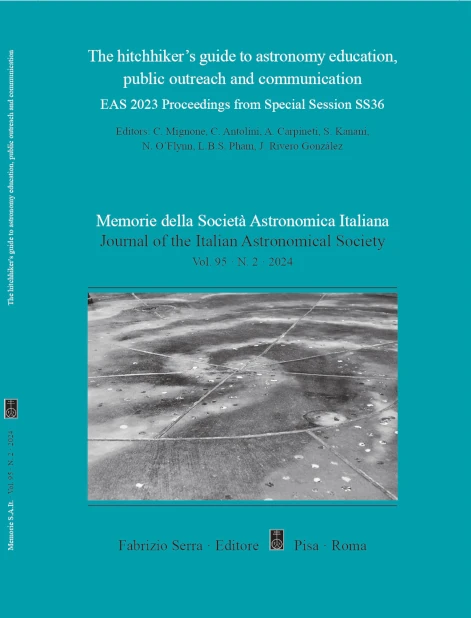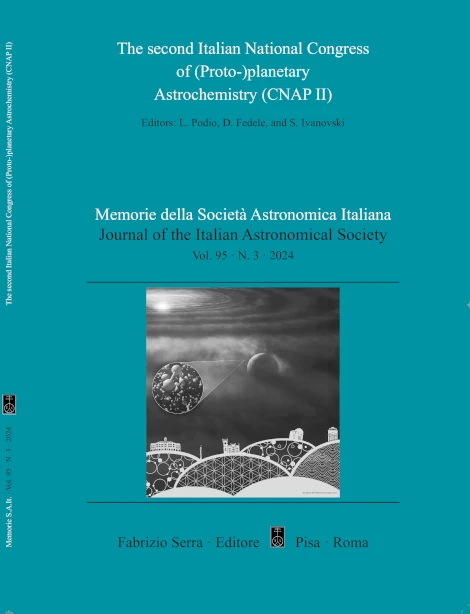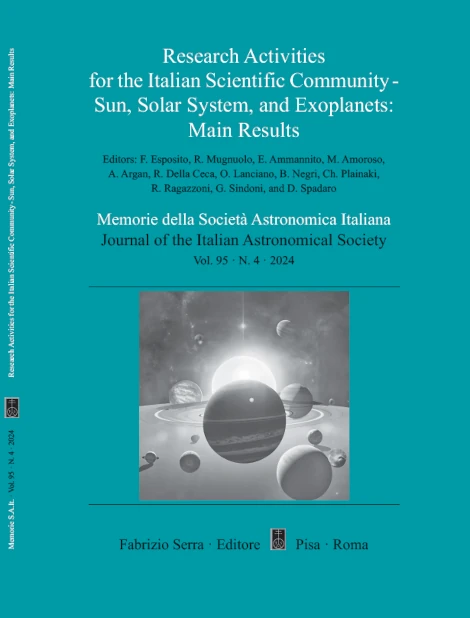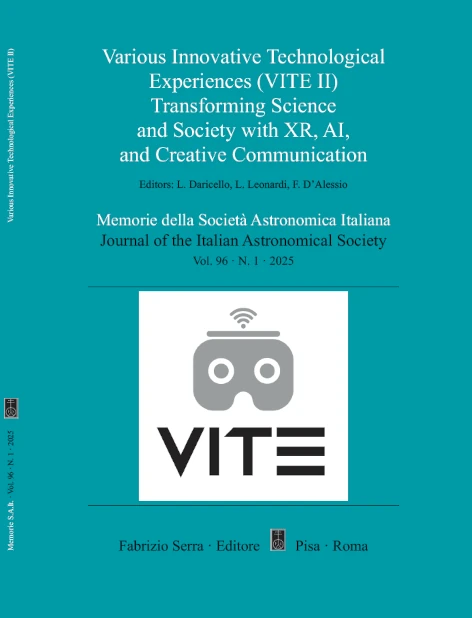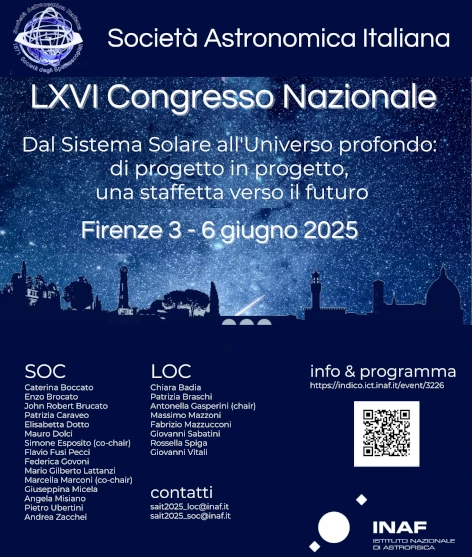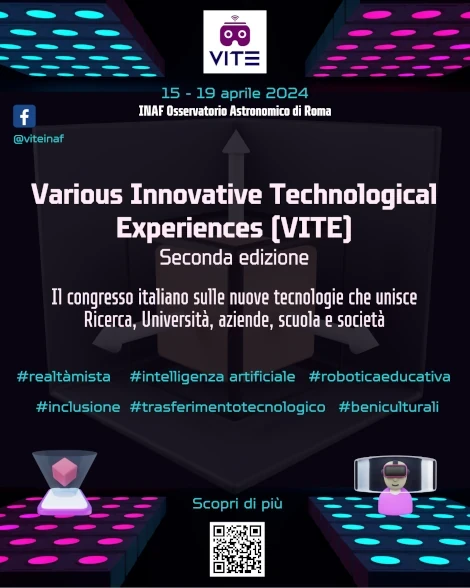Searh results
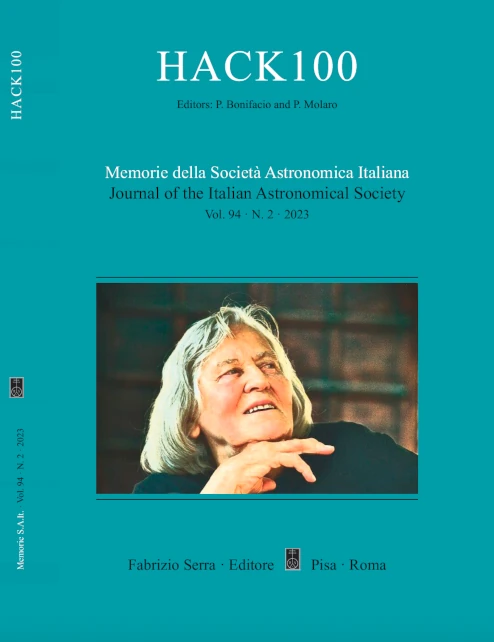
Volume 94, n. 2, 2023
HACK100
Editors: P. Bonifacio and P. Molaro
| Index | |
| Foreword |
Margherita’s work and legacys
| P. Selvelli | Margherita Hack: a life for science DOI: https://doi.org/10.36116/MEMSAIT_94n2.2023.13 |
| P. Molaro | The problem of Lithium and the other Light Elements Deuterium, Beryllium and Boron DOI: https://doi.org/10.36116/MEMSAIT_94N2.2023.22 |
| S. Ferluga | The strange Case of Epsilon Aurigae DOI: https://doi.org/10.36116/MEMSAIT_94N2.2023.28 |
| G. Umbriaco, A. Bianchini, A. Pizzella, A. et al. | Margherita Hack’s Astrophysics at the Asiago Astrophysical Observatory DOI: https://doi.org/10.36116/MEMSAIT_94N2.2023.34 |
| M. Messerotti | Solar radio observations in Trieste contributed to avert a nuclear war in 1967 DOI: https://doi.org/10.36116/MEMSAIT_94N2.2023.40 |
| G. Catanzaro | Am Stars: Abundances, ages, pulsations, and binarity DOI: https://doi.org/10.36116/MEMSAIT_94N2.2023.50 |
| P. Bonifacio, L. Monaco | Feige 86: Gaia confirms its Horizontal Branch nature DOI: https://doi.org/10.36116/MEMSAIT_94N2.2023.57 |
| A. Wolter | A statue for Margherita DOI: https://doi.org/10.36116/MEMSAIT_94N2.2023.61 |
Galactic archeology and formation of chemical elements
| E. Caffau | Searching for metal-poor stars DOI: https://doi.org/10.36116/MEMSAIT_94N2.2023.68 |
| J. I. González Hernández, D. S. Aguado, C. Allende-Prieto et al. | Early phases of the Galaxy from the chemical imprint on the iron-poor stars J0815+4729 and J0023+0307 DOI: https://doi.org/10.36116/MEMSAIT_94N2.2023.77 |
| I.Vanni, S. Salvadori, Á . Skúladóttir | Are all metal-poor stars of second-generation? DOI: https://doi.org/10.36116/MEMSAIT_94N2.2023.84 |
| A. Bressan, G. Costa, S. Goswami, V. Grisoni, K. G. Shepherd, L. Silva, F. Addari, P. Marigo | Very massive stars chemical enrichment in extremely metal-poor galaxies DOI: https://doi.org/10.36116/MEMSAIT_94N2.2023.91 |
| L. Lombardo | CERES survey: Stellar parameters and chemical abundances of selected elements DOI: https://doi.org/10.36116/MEMSAIT_94N2.2023.99 |
| F.-K. Thielemann, K. Farouqi, S. Rosswog, K.-L. Kratz | Sources of r-Process Abundances DOI: https://doi.org/10.36116/MEMSAIT_94N2.2023.105 |
| M. Molero, D. Romano, M. Reichert,F. et al. | Chemical evolution of Sagittarius: the heavy elements Eu and Ba DOI: https://doi.org/10.36116/MEMSAIT_94N2.2023.118 |
| A. Vasini, F. Matteucci, E. Spitoni | Chemical evolution of radioactive elements in the Milky Way DOI: https://doi.org/10.36116/MEMSAIT_94N2.2023.123 |
| F. Matteucci | The chemical evolution of the Milky Way: a problem of Galactic archaeology DOI: https://doi.org/10.36116/MEMSAIT_94N2.2023.127 |
| E. Spitoni, F. Matteucci | The [Α/Fe] bimodality in the Milky Way disc with chemical evolution models DOI: https://doi.org/10.36116/MEMSAIT_94N2.2023.134 |
| S. Taibi, G. Battaglia, R. Leaman et al. | Radial metallicity gradients of red giant stars in Local Group dwarf galaxies DOI: https://doi.org/10.36116/MEMSAIT_94N2.2023.141 |
| F. Z. Majidi | Characterization of YSOs with XSHOOTER DOI: https://doi.org/10.36116/MEMSAIT_94N2.2023.147 |
| A. Herrero | A personal perspective on the history of massive OB stellar spectroscopy DOI: https://doi.org/10.36116/MEMSAIT_94N2.2023.154 |
| G. Costa, C. T. Nguyen | Rotating stellar populations in NGC 1866: New PARSECv2.0 tracks with rotation DOI: https://doi.org/10.36116/MEMSAIT_94N2.2023.167 |
| A. Mucciarelli, D. Massari | The assembly history of the Local Group: the case of the Large Magellanic Cloud DOI: https://doi.org/10.36116/MEMSAIT_94N2.2023.173 |
Exoplanets discovery and characterization
| A. Sozzetti | Planetary Systems Demographics: The View from High-Resolution Spectroscopy DOI: https://doi.org/10.36116/MEMSAIT_94N2.2023.178 |
| K. Biazzo & the GAPS Team | Characterization of exoplanet hosting stars within the GAPS program DOI: https://doi.org/10.36116/MEMSAIT_94N2.2023.189 |
| S. Benatti, S. Desidera & the GAPS Young Objects Team | Understanding the evolution of planetary systems with GAPS2 DOI: https://doi.org/10.36116/MEMSAIT_94N2.2023.195 |
| L. Silva, R. Bevilacqua, L. Biasiotti, E. et al. | Climate and atmospheric models of rocky planets: habitability and observational properties DOI: https://doi.org/10.36116/MEMSAIT_94N2.2023.203 |
Extragalactic Astronomy: Tracing the baryons- First Galaxies and their growth
| C. Péroux | The Baryon Cycle DOI: https://doi.org/10.36116/MEMSAIT_94N2.2023.211 |
| S. Salvadori, V. D’Odorico, A. Saccardi, Á . Skúladóttir, I. Vanni | First stars signatures in high-z absorbers DOI: https://doi.org/10.36116/MEMSAIT_94N2.2023.215 |
| A. Grazian | The contribution of high-z AGN to the Ionizing UV background DOI: https://doi.org/10.36116/MEMSAIT_94N2.2023.221 |
| O. Cucciati, G. De Lucia, F. Fontanot, G. Zamorani, B.C. Lemaux, L. Lubin | Galaxy and structure formation before the cosmic noon. The perspective with galaxy spectroscopic surveys DOI: https://doi.org/10.36116/MEMSAIT_94N2.2023.227 |
| B.Vulcani, B. M. Poggianti, A. et al. | Integral field spectroscopy allows us to distinguish among the different physical mechanisms affecting galaxies in the different environments DOI: https://doi.org/10.36116/MEMSAIT_94N2.2023.233 |
| R. Tripodi, C. Feruglio, F. Fiore, et al. | ALMA unveils an outflow and a stellar bulge in an isolated z ∼ 6 QSO DOI: https://doi.org/10.36116/MEMSAIT_94N2.2023.240 |
| S. Maitra | Higher order clustering of Lyα forest DOI: https://doi.org/10.36116/MEMSAIT_94N2.2023.247 |
Cosmology and fundamental physics
| S. Cristiani, K. Boutsia, G. Calderone, G. et al. | Spectrographs and spectroscopists for the Sandage test DOI: https://doi.org/10.36116/MEMSAIT_94N2.2023.251 |
| M. Signorini, G. Risaliti, A. Sacchi, E. Lusso, E. Nardini | Building the high-redshift Hubble Diagram with quasars DOI: https://doi.org/10.36116/MEMSAIT_94N2.2023.259 |
| P. Monaco on behalf of the Euclid Consortium | Mapping the Universe with slitless spectroscopy DOI: https://doi.org/10.36116/MEMSAIT_94N2.2023.266 |
| D. Milaković, C.C. Lee, P. Molaro, J.K. Webb | Methods for quasar absorption system measurements of the fine structure constant in the 2020s and beyond DOI: https://doi.org/10.36116/MEMSAIT_94N2.2023.270 |
Breakthrough science enabled by future spectrographs
| S. Covino, S. Cristiani, J. M. Alcal´a, et al. | CUBES: a UV spectrograph for the future DOI: https://doi.org/10.36116/MEMSAIT_94N2.2023.281 |
| C. Neiner | UV spectropolarimetry: a new tool for breakthrough science DOI: https://doi.org/10.36116/MEMSAIT_94N2.2023.294 |
| S. Iglesias-Groth | A search for mid-IR bands of amino acids in the Perseus Molecular Cloud DOI: https://doi.org/10.36116/MEMSAIT_94N2.2023.302 |

